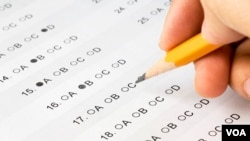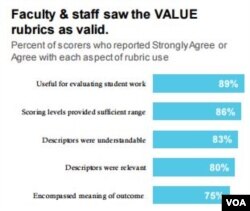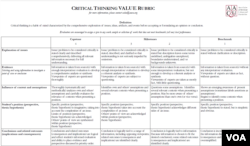Server error
Oops, as you can see, this is not what we wanted to show you! This URL has been sent to our support web team to the can look into it immediately. Our apologies.
Please use Search above to see if you can find it elsewhere
querystring="?embed_html=src%3A%3A%2F%2Fgiphy.com%2Fembed%2FukkuAjAmtC3LO%7C%7Cwidth%3A%3A480%7C%7Cheight%3A%3A248">
Giphy Embed ImageEducators have proposed a way to evaluate student learning as an alternative to traditional standardized tests.
Measuring a student’s abilities when they graduate with an academic degree is difficult. Measuring that student against students from other institutions with the same degree complicates the results.
The initiative -- called the Valid Assessment of Learning in Undergraduate Education, or VALUE – is being tested by 92 colleges and universities across the U.S. Led by the Association of American Colleges and Universities (AACU). It has worked with professors across the country since 2008 to create the VALUE approach.
VALUE measures the skills students need in the professional world. These skills include critical thinking, written communication and advanced math. The reviewers looked at 21,000 pieces of student work, including essays, research papers, chapters from student thesis, and problem sets.
When measuring critical thinking, VALUE looks at how well students can explain different issues. It also looks at how well students use evidence to explain their thinking.
So far, VALUE shows that students show strength in critical thinking by explaining issues and presenting evidence. However, “students have greater difficulty in drawing conclusions or making sense out of or explaining the importance of the issue studied.”
Student writing has improved at colleges and universities that have focused on that skill. But, “the effective use of evidence to support written arguments … continues to be a challenge,” AACU says in their “On Solid Ground” report on VALUE issued in February.
Lastly, in the category of “quantitative literacy,” students showed strength in calculation and interpretation. However, “the results suggest that more emphasis has been placed on the mechanics of math-related skills and less attention on ‘why, when and where’ of using quantitative approaches.”
Educators involved in VALUE created a rubric, or a document, that states the expectations for an assignment and describes levels of quality from excellent to poor. The VALUE rubric has a scale from one to four, one being the most basic ability level a college student should have in that skill.
Schools use the rubric to measure the projects and assignments, and to measure how students’ skills are progressing with those projects and assignments.
Natasha Jankowski is the director of the National Institute for Learning Outcomes Assessment. Her organization studies testing and assessment in all levels of education.
She says VALUE is a much better way for schools to measure the success of their students. Before, many schools only gave standardized tests because that was the norm.
The VALUE approach not only helps schools report on outcomes. It also clarifies abilities of graduates from different schools.
“Now our students are in a position to talk about their education differently … with employers,” Jankowski said. “Instead of referring to classes that they took, they can talk about the knowledge and skills that they have in ways that they can demonstrate.”
Since 2015, the VALUE rubric has been downloaded by more than 42,000 representatives of 4,200 educational organizations.
“This is applicable across disciplines and institution types,” says Anne Jenkins, AACU communications director, “and the first large-scale model for assessing student achievement across an institution that goes beyond testing.”
Please leave a comment here, and visit us on Facebook, Twitter, Instagram and LinkedIn, thanks!






